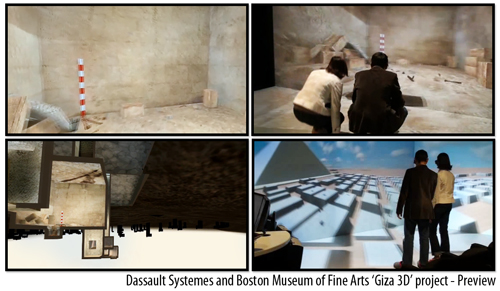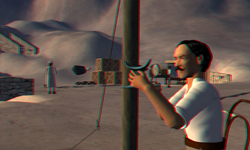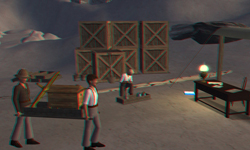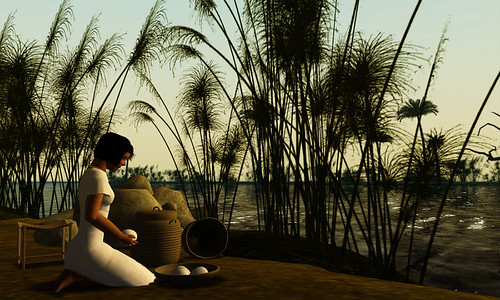 The Museum of Fine Arts, Boston and 3D software company Dassault Systèmes have announced they will join forces in a partnership that aims to bring the power of industry as well as experimental 3D to the domain of archaeology. The MFA’s Giza Archives Project digital database will be “the first to benefit from the power of interactive, immersive and multi-platform 3D experiences” as the team intents to create new possibilities for the visualisation of archaeological data for both the scientific community and the general public. (preview video 1 – preview video 2)
The Museum of Fine Arts, Boston and 3D software company Dassault Systèmes have announced they will join forces in a partnership that aims to bring the power of industry as well as experimental 3D to the domain of archaeology. The MFA’s Giza Archives Project digital database will be “the first to benefit from the power of interactive, immersive and multi-platform 3D experiences” as the team intents to create new possibilities for the visualisation of archaeological data for both the scientific community and the general public. (preview video 1 – preview video 2)
Visualisation of Archaeological Data for Education and Research
With the ‘Giza 3D’ project Dassault Systèmes – which usually focuses on 3D software for product design and virtual simulations, with an odd visit to the Pyramid of Khufu and its much debated internal ramp theory – is challenging itself to put its expertise and 3D lifelike experience technologies at the heart of education and research. To achieve this, the collaboration between the Boston museum and the French innovator will focus on ‘immersive’ multi-platform archaeology experiences. These may be individual or collective, and may be experienced through online devices or through more complex virtual and augmented reality systems, using game consoles, 3D screens or even movie theatres.
The virtual reconstruction of the Giza plateau is based on archaeological data stored in the ‘Giza Archives Project’ massive database. Housed at the MFA, the digital library contains more than 40 years of information on the Egyptian Pyramids and the Giza Plateau itself.
The Giza Archives Project
Most of the archaeological documents and photographs in the collection have been assembled over forty years of excavations by Egyptologist George Reisner, who led the Harvard University-Boston Museum of Fine Arts expedition in Egypt. In the last decade the historic expedition photographs, excavation diaries and field books, maps, plans, notebooks and sketches from the ancient tombs and pyramids at Giza were all digitised and made accessible on the web.
To keep the archives up to date, the Giza Archives Project partners today with museums and universities that house major collections related to Giza, as well as constantly adding information from recent MFA fieldwork and from other expeditions.
The Future of Exploring the Past?
According to the Dassault Systèmes and the MFA (and we couldn’t agree more), the collaboration between technology and archaeology will result in new forms of scientific inquiry and communication. Virtual archaeology will raise new questions and offer new hypotheses, and also allow researchers to simulate these in virtual environments.
“These tools and approaches offer new dimensions to Egyptological research, allowing for innovation and enhanced knowledge sharing,” said Giza Archives Director Peter Der Manuelian.
For a preview of what to expect from this partnership, definitely check out the two videos embedded here. The ‘Giza 3D Preview’ video takes us on a virtual tour of Cemetery G2100 (high-resolution renders of this area were used to illustrate the book ‘Mastabas of Nucleus Cemetery G 2100‘) at the Giza Plateau and the ‘Immersive Experience’ video documents a ‘virtual reality’ visit to one of the mastaba tombs located on the Plateau.
The latter reminds me of the demo given at the KAUST visualization facilities, where the focus was on ‘getting the bigger picture’ of an excavation by visualising all the different archaeological strata at once – something impossible for an archaeologist in the field. Der Manuelian mentions the overview of different construction periods in an interview on the 3D Perspectives blog, with the added benefit that “the wall reliefs, paintings, and inscriptions – some now in museums around the world – will show up back on their original tombs walls, etc.”
Giza 3D – Wishlist from a ‘general public’ PoV
Honestly, I can’t wait to access Giza 3D, and I’m curious to see which platforms the models will be ported to. Some thoughts:
Can the virtual me come too?
Spending a large (or moderately large) amount of time in a 3D environment just feels more comfortable when you are actually there – in a virtual way, of course. It gives a better perspective on the size of objects and distances, and gives you an ‘anchor’ point when scanning through a tomb with four identical stone walls.
Dassault Systèmes experimented with photorealistic avatars as early as 2008, but the statement issued by DS and the MFA does not specifically mention the user having a virtual representation when visiting Giza 3D. Yet this might be implied when mentioning bringing the virtual plateau to game consoles – unless they plan use a first person shooter style field of view. Come to think of it, the Giza Plateau would make an excellent map for a WWI combat game.
Collective use also requires a virtual appearance. Collaborating long-distance, you do want to have an idea who else is in the room virtual tomb, and have chat and voice call functionality, plus the obligatory ‘mute’ option.
Delivery methods and platforms
It remains to be seen whether the data itself will be included with the software needed to see it, as in IBM’s Forbidden City, or whether you will need to download extension packs like for the Sims (Prad strongly advises ‘World Adventures’). Data might alternatively be downloaded real-time as you are exploring the environment, which is what happens when you visit King Tut Virtual. Although this demands more bandwidth and system resources, it allows for instant updates, more freedom beyond pre-programmed views and far-reaching interaction, where users can even collaborate to add to the area in real-time.
Of course, they could opt for an in-browser solution, but often that doesn’t allow for the use of avatars, and would still require the installation of plug-ins, or the use of a specific browser.
Game consoles are built specifically for rendering 3D data as fast and effective as possible, so seem the ideal solution for ‘home schooling’ (excavating the Giza Plateau on the Wii should be quite the educational workout?) and research labs might be more likely to acquire a budget for a big-screen TV rather than a complete VR system.
Augmented Reality visit to the Giza Pyramids
Who needs a guide, when you can have a phone that tells you all? And who cares that some of the tombs are closed, if you can still descend virtually? I’m not quite sure how good the 3G coverage (and thus GPS positioning for phones) is at the Giza Pyramids, but would it not be amazing when you can stroll the area, using a heads-up display (or if on a budget, your iPhone or Android) to call for further information such as dating of tombs, artefacts discovered or to access a closed down area. Audio tours are so 20th century!
NPC’s at Heritage Key’s ‘King Tut Virtual’, working late, as the end of this dig season is quickly approaching.

Who will I meet?
I’m not proposing a dating service for people interested in Ancient Egyptian history (any demand for that?), but the ultimate addition – in my opinion – to Giza 3D would be NPC’s. Non-player characters driven by natural language artificial intelligence systems could offer more information, answer questions, and just keep the general public company on their virtual tour. The NPC would be someone more or less real who gives you directions when you’re lost, and remembers and greets you upon your next visit. They could be ancient Egyptian (we have the Amesbury Archer at Stonehenge Virtual) or more contemporary (Carter’s excavation team at the Virtual Valley of the Kings), as long as they give you a sense of human occupation and ongoing activity.
The above is mostly a wishlist for Giza 3D, and the evolution of (authentic historical) virtual environments in general. Much of the technology needed already exists (reasonably intelligent NPCs, procedural modelling, augmented reality applications for phones, VR systems, 3D televisions, different platforms for virtual worlds and render engines) but a lot of expertise is needed to puzzle them all together. Looking at previous Dassault Systèmes projects, and combining that with the mass of information gathered by the Giza Archives Project, it can only be concluded that ‘Giza 3D’ is something you must keep an eye upon.
Other 3D, Virtual and Immersive ‘historical’ projects out there
Sadly, the 3D Giza plateau isn’t open to the public yet, but there are plenty of other interesting projects that mash up VR systems, digital modelling, virtual worlds, new platforms and social media integration, as well as user generated content and archive materials and are definitely worth exploring. My favourites at the moment:
King Tut Virtual & Stonehenge Virtual
Heritage Key’s very own open-source based virtual environment, where you can explore Howard Carter’s discovery of King Tut’s tomb in the Valley of the Kings, stroll along the Nile at Amarna (mind the hippos!) or experience the summer solstice at the world’s most famous stone circle. And did I mention that you can also access KV62 to marvel at the wall paintings, order your avatar to help build Stonehenge (don’t worry, virtual megaliths aren’t as heavy) and time-travel to the Durrington Walls Settlement? Start by creating your avatar, or if you already have yours (splendid!), log in and go directly to the Welcome Area.
3D Rome and Venice
Not a virtual environment in itself, but an algorithm that constructs 3D models by ‘sourcing the masses’. Using publicly available photographs they generate models for cities and monuments, a possible alternative to laser-scanning techniques. Rome was built – most likely not in a day – from 150,000 photographs, and for Venice 250,000 images were used. Learn more about 3D Rome and the future of the project in Bija’s interview with Noah Snavely.
Virtual Sambor Prei Kuk
The virtual recreation of the 7th century Khmer temple complex does not claim absolute historical accuracy, but is definitely worth a download and virtual visit. Professor Kalay stresses that the aim was to create a complete experience, rather than 100% accuracy, “instead, we have tried to provide an experience that will convey, as best we can, the sense of ‘being’ at Sambor Prei Kuk in the 7th century AD.” And they have well succeeded.
Virtual Sambor Prei Kuk also gets extra points for the most original splash screen on load.
Digital Karnak
The UCLA’s Digital Karnak is a three-dimensional virtual-reality model that runs in real time and allows users to navigate 2,000 years of history at the ancient Egyptian religious site Karnak, one of the largest temple complexes ever constructed.
That might sound a bit more impressive than it is – a model overlay on Google Earth – but the lack of graphic ‘wows!’ is most definitely made up for by the ability to scroll through the construction of and changes made to the Karnak temple complex over time (from Senusret I up to Ptolemy VIII) and the additional information available, including high-quality renders of the models you see on Google Earth and contemporary video footage to see how the site looks now.
I’d love to test out some ‘AR apps’ that combine tourist and/or historical information with sites or museums in Britain, but have not stumbled over one yet. If you know of any – preferably for iPhone, but Android would do as well – do let me know in the comments!




